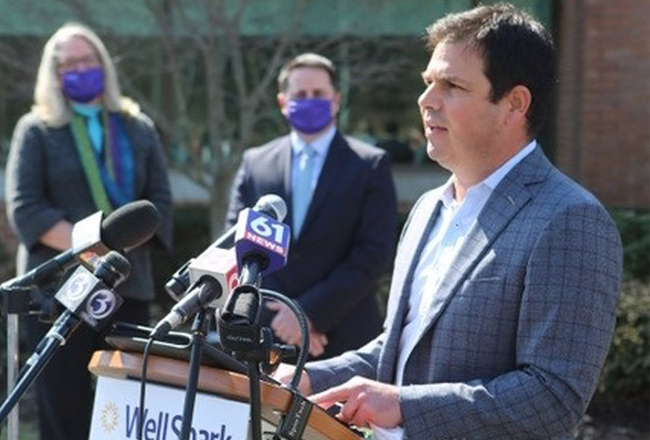Determining which states did best during the darkest days of the pandemic can be a challenge.
According to an April 1 WalletHub report, Connecticut was ranked the 16th “safest” state during Covid-19 (Massachusetts was 43rd; New York placed 50th), while as of February ”” the latest figures available ”” its 8.5% unemployment rate was tied with California for the country”™s third-highest, behind Hawaii (9.2%) and New York (8.9%).

And yet, the Nutmeg State is still flaunting its record-high $3 billion rainy day fund; earlier this month it received its first bond rating upgrade since 1988, from Moody”™s; and it is due over $10 billion from the federal government”™s $1.9 trillion American Rescue Plan Act.
“I”™m very positive on Connecticut over the next two years,” Department of Economic and Community Development Commissioner David Lehman told the Business Journal.
While it would be bigger news if a high-placed member of Gov. Ned Lamont”™s administration was expressing a negative outlook, Lehman had more statistics to back himself up.
According to the U.S. Bureau of Labor Statistics, Connecticut ended the fourth quarter of 2020 with a GDP increase of 7% ”” the fourth-highest in the nation ”” for an estimated full-year total of $288.9 billion, a mere 0.6% drop-off from 2019”™s $290.7 billion. (U.S. GDP declined by 2.33% over the same period.)
Lehman noted that the state recorded the starts of about 40,000 new businesses last year, according to the Connecticut Data Collaborative. Offset by closings, the state netted 15,858 for 2020, compared with a loss of 370 for 2019.
“Our challenge now is to get out the message that Connecticut is a good place to invest and do business in,” Lehman said. “That wasn”™t always the case before.”
Indeed, Connecticut”™s years-in-the-making reputation as not being “business-friendly” continues to dog it, despite some key changes in how it goes about trying to attract companies and retain those already established in the state.
One recent splashy win came with the announcement earlier this month that The Hornblower Group had signed a lease agreement with Bridgeport Boatworks that will bring up to 100 jobs to that city.
“We”™ve got some others in the pipeline,” Lehman said. “Some that were deferred during the pandemic, some that have come up more recently.”
He indicated that more announcements will be made in the short term.
The commissioner acknowledged that the state is still trying to capitalize on the influx of residents from New York state, which he said has been close to 20,000 according to the latest DECD data. (The U.S. Postal Service estimated there were some 16,500 relocations into the state based on change of address requests last year, with most of those from New York; slightly more than 7,000 such moves took place in 2019.)
Thinking local
“We have to make sure we”™re providing the right sort of engagement,” Lehman said, “which starts on the local level. There are going to be people who move here and decide it”™s not for them and those who decide it is for them.
“We can compete on our merits, which includes the rainy day fund, the credit upgrade and how well we”™ve done with vaccinations,” he continued. “Now we need to make people feel welcome, that this is where they should be for the long term ”” and then hopefully companies will follow.”
Those thoughts were the theme of an April 7 virtual presentation hosted by the Greater Danbury Chamber of Commerce, wherein a pair of senior managers at Accenture outlined how states can hang on to pandemic-inspired population booms.
“This is your talent pool,” said Stephen Nocera, former director of Danbury”™s office of project excellence and co-author of Accenture”™s “Creating Home” report.
The plan, co-written by Laura Zucker, recommends a kind of updated “welcome wagon” approach ”” gifts of coffee from a local shop or a free yoga class ”” as well as making concerted efforts at engaging with new residents/companies to keep them in the community.
“In the past, a crisis passes and people go back” to where they were originally, Zucker noted. “You can”™t just assume they”™re going to stay here for the long haul.”
Meanwhile, Lehman said completing the restructuring of the Connecticut Property Transfer Act ”” which could create as many 27,000 jobs and result in the sale of some 4,200 properties ”” was “critical.
“(The act) had created uncertainty, and made it harder to clean up properties so they could be sold,” he continued. “I have no doubt (changing it) will make a big difference.”
While Connecticut has received plaudits for its swift response to Covid-19 when it arrived, Lehman said, “There was no ”˜special sauce”™ involved, other than recognizing the problem quickly and having a lot of coordination on the side of the executive branch side.
“There was no playbook from mid-March through April and even May,” he continued. “We needed to try and understand what was happening with the virus with the best information that we had at the time. And we understood it was a matter of prioritizing the health crisis first, but ultimately finding a balance between public health and how we went about reopening businesses.”
One black eye for the DECD came from a recently published audit of the agency, which found that it forgave $97 million in loans from 2017 to 2019 ”” Lehman was confirmed as commissioner in late March of 2019 ”” which included $1.7 million in loan forgiveness for companies that did not meet the hiring goals on which those loans had been predicated; in fact, some even reduced their workforce.
“You have to be mindful of what can happen in changing economic times,” he said. “Sometimes bad stuff happens to good businesses.”
Nevertheless, he added, “This is why this administration has chosen to take a different approach when it comes to taxpayers”™ providing incentives to bringing businesses here. With our incentive programs, you get the money after the jobs are created.”





















